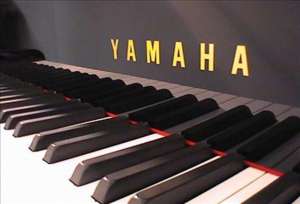
[The following is the text of a handout written by Wilton Syckes intended to answer concerns raised by prospective used piano customers.]
Questions and Answers
About
Previously Owned
Yamaha and Kawai Pianos
Seasoned for World-Wide Destination
Question: Where are these pre-owned pianos built?
Answer: Each and every piano we import was built ONLY IN JAPAN! Contrary to some crazy rumors, they were NOT made in Taiwan, China, Korea, or elsewhere in Asia.
Question: Where in Japan do we obtain these used pianos?
Answer: Hither and Yon! Everywhere! Our Japanese associates constantly search the country for pianos that meet OUR specifications for the various grades we have established.
Question: These pianos, having been manufactured IN JAPAN, won’t they develop physical problems when brought to the United States?
Answer: Emphatically NO! Neither Yamaha nor Kawai ever ran two production lines. The pianos they have built are ALL THE SAME, and have been shipped to every corner of the world. Serial numbers are in consecutive order, no matter to what country the piano was sent. Parts for the piano WE import are interchangeable with those sold by YAMAHA CORPORATION OF AMERICA, based in Buena Park, California.
Question: Didn’t YCM have some dryness problems with cases and pin-blocks when they first imported pianos from their Japanese factory?
Answer: Yes, but only in the very first shipments. Within the first few months production changes were made to avoid future problems. You should know that we DO NOT import YAMAHA pianos made in the early 1960s, except as Grade J. [Ed Note: Grade J is “Junk” pianos, the worst grade possible.]
Question: Aren’t the climatic conditions in the United States different from those in Japan? If so, isn’t it possible for these pianos to “fall apart” in this country?
Answer: The United States runs the gamut of weather conditions throughout the world! Nowhere is there such diverse climatic variations as in this country.
Question: YAMAHA CORP. OF AMERICA refers to these pianos as GRAY MARKET, being distributed by “non-authorized wholesalers representing the pianos to be of a similar quality as regular YAMAHA instruments”. How do you respond?
Answer: Webster defines Gray market as “A place of system for selling scarce goods secretly above prevailing prices, a practice co0nsidered unethical although legal”. It must be quite obvious, SYCKES PIANO IMPORTS is NOT selling GRAY MARKET goods, nor do we operate in an unethical manner!
Question: Please explain “Seasoned for Destination”. How does it relate to the pre-owned pianos imported by SYCKES PIANO IMPORTS?
Answer: In the United States every conceivable climatic condition can be found, from the high humidity of Miami and Houston to the dry cities of Phoenix and Denver. San Diego is totally different from Akron; Boston vs. Minneapolis, etc. etc. You will find our pianos in virtually EVERY city in the country, serving the purpose they were purchased for! It is ludicrous to even suggest that ANY piano manufacturer can “season or destination” and by so doing “determine the moisture content of the wood for the market for which it is destined”, as recently stated by a YAMAHA (of America) executive!
Question: Are used KAWAI or YAMAHA pianos imported here by their American affiliates?
Answer: Definitely yes for Kawai; POSSIBLY (but we have no proof) for Yamaha. One would suspect a double set of standards, wouldn’t one!
Question: What warranty backing can be expected?
Answer: Used piano warranties are the responsibility of the selling dealer. As a general rule, manufacturers do not provide warranties except for the ORIGINAL customer.
Question: What’s the scoop on the fact that many Yamaha and Kawai grand pianos have only two pedals? Does this indicate the piano is, indeed, a Gray market piano?
Answer: No, No, No! Two pedal grands were, since Cristofori days, the choice of piano builders throughout the entire world, except in this country where people insisted on having a middle pedal. Probably only ONE out of ONE HUNDRED have any idea what this pedal does, let alone even know how to spell the word SOSTENUTO.
Question: When did the Japanese Yamaha and Kawai factories decide to discontinue product pianos with only two pedals?
Answer: Kawai, in about 1973 saw the light; YAMAHA, not until about ten years later. Both companies informed their world-wide customers that, in the interest of more efficient production ALL grand pianos would have THREE pedals; thus a large cost savings!
Comment: Victor Borges, world-famous pianist and entertainer, has said over and over again, “THE MIDDLE PEDAL SIMPLY SEPARATES THE LEFT FROM THE RIGHT”!
Question: What about a crack in a soundboard? Does it affect tonal quality?
Answer: Most likely many, if not most used grand pianos have at least one or more cracks in the soundboard. This is especially true in more expensive instruments, those that use the better grades of Sitka, Adirondack or European solid spruce. Provided the crown of the soundboard remain intact, the odds of tonal change is highly unlikely.
Question: How do you define, and/or establish that a true crack exists in a piano?
Answer: Such a crack will be one that is open to the eye. From the top clean through the board. If this is the case, either a business card can be slid through or light from a flashlight can be seen from bottom to top. Most “cracks” are totally harmless!
Comment: Do not confuse a so called crack with a minor seal separation; or a pressure ridge known in the trade as a menori (a Japanese term). The latter two conditions are quite common, having absolutely no adverse effect, other than COSMETIC! Please note that SEAMS ACT AS EXPANSION JOINTS, thus allowing for very slight openings to appear under extreme dry periods, no matter where the piano may be in use. When the humidity level increases, these insignificant openings will disappear!
Question: Explain your grading system. Is it the same used by other piano importers?
Answer: We are protective of our grading system! Pianos sold by us adhere to very strict standards in Grades established by Wilton Sykes, of Sykes Piano Imports.
As “A” grade piano, be it upright or grand, is, for all intents and purpose ready for the dealer’s floor, with only slight preparation necessary.
A minus (A-) and B plus (B+) will show some wear; perhaps have a pressure ridge and maybe a slight finish blemish, but for the most part a great piano, easy to sell!
B grade pianos are simply excellent used pianos, the kind you once in a while run into in your home town. Imperfections such as case blemishes, minor finish fissures, soundboard “memories”; hardware needing polished – all possibilities, but not all in each piano! Should minor corrosion appear on treble wire strings, it can be easily removed with a SCOTCHBRITE brand pad. No residue will be left on strings or soundboard.
Comment: Our grading system is unlike any other in the industry. We purchase our pianos on the open market in Japan and pay according to our supplier’s grading system. Each piano is personally inspected at our warehouses; then assigned a NEW grade by Mr. Syckes. The piano MUST meet his exacting grade requirements before it is shipped to a dealer.
Question: Please provide more information about late model three-pedal grand pianos.
Answer: They are in very short supply, especially YAMAHA, but those we offer are just like new, and for the most part come from prestigious music conservatories and universities. Unlike in America, pianos are extremely well cared for in any and all public places. We could easily grade them as A plus (A+) because that’s the quality you will receive!
Question: Why should YOU sell a used YAMAHA OR KAWAI?
Answer: Profit is the best reason, or course! And, notwithstanding, the satisfaction of giving your customer a piano of high quality at an attractive price. Interestingly enough are the large number of well-known YAMAHA (new) dealers who buy ONLY from us!
Question: Why should YOUR customers buy a used piano? In particular, what makes one imported by SYCKES PIANO IMPORTS the best selection?
Answer: The prices of all new Japanese (and Korean) pianos have skyrocketed. It seems the manufacturers can think only one way regarding pricing – and that is always UP! So saving money for your customers is the right way to go, and when you sell only pianos imported by SYCKES PIANO IMPORTS, you are selling the very best. There are other “Johnny-Come-Lately” outfits asking for your business, but SYCKES has the reputation for honesty, credibility, and integrity others envy. Wilton Syckes has been in the piano business since 1950, and has been selling pre-owned YAMAHA and KAWAI grand and upright pianos to discriminating merchants since 1984. You will be buying with complete confidence when you place your order with one of his several representatives, or directly from him. Don’t wait; start making PROFITS today!
Guaranteed Landed Quality
That’s Our Motto – That’s Our Promise
The Debate about Yamaha Pianos – Executive Summary
Part 1: Problem Statement
Part 2: Yamaha Corp. of America’s Advertisement
Part 3: Wilton H. Syckes’ Editorial Response
Part 4: A History Lesson, by Wilton Syckes
Part 5: Give Me a Break, by Wilton Syckes
Part 6: FAQS about Previously Owned Yamaha and Kawai Pianos, by Wilton Syckes
Part 7: Seasoned for Destination, by Tom Donahue
Part 8: Gray Market Yamaha Pianos – What is the Truth? By Craig Whitaker
Part 9: A Conclusion










You must be logged in to post a comment.